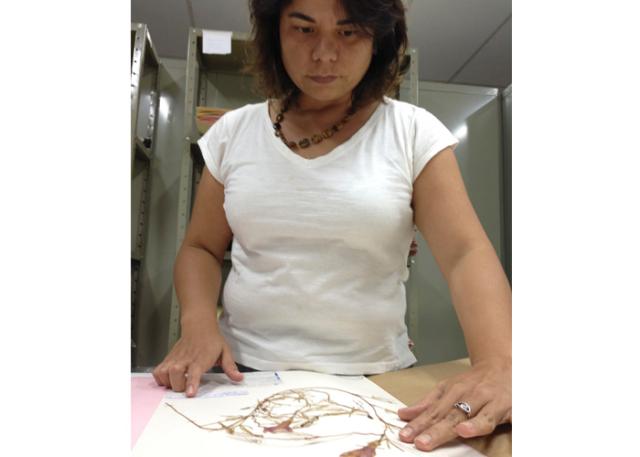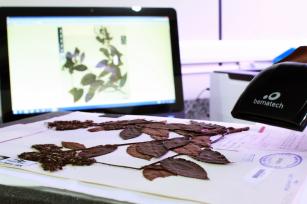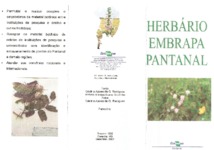New plant species only found in Pantanal is discovered
New plant species only found in Pantanal is discovered
Thirty years after it was collected from nature, a new plant species was discovered and catalogued by science. Only found in Pantanal, Ipomoea pantanalensis J.R.I.Wood & Urbanetz had been deposited in the 1990s by then Embrapa Pantanal researcher Arnildo Pott (currently retired), who stored it in the research center's herbarium. Pott collected two specimens of the new species and catalogued them as previously known species (Ipomoea subrevoluta and Ipomoea emetica).
The researcher John Wood, from the University of Oxford, in the United Kingdom, visited the Brazilian herbarium and noticed that the stored material did not correspond to the known species. In 2016, the new plant, a liana from the sweet potato family, was officially recognized through publication in the scientific periodical Kew Bulletin.
The discovery was possible thanks to the online availability of data from the Embrapa Pantanal herbarium since January 2013 on the initiative of the curator Catia Urbanetz. This allowed researchers from anywhere in the world to have access to their content. By consulting the Species Link network, to which the herbarium is connected, the English botanist found the samples he was searching for in the Brazilian collection. Wood visited Embrapa Pantanal in January 2014, which enabled updates and corrections in the identification of samples from the botanical family in which he specializes (Convolvulaceae).
Wood analyzed the two exemplars Pott collected in the 1990s, which were identified as Ipomoea subrevoluta and Ipomoea emetica. The British scientist verified that the identification of both materials was incorrect and actualized that it was a new species, as the flower traits of those two plants were different from those in the species under which they had been originally catalogued.
The name given to the newly-discovered plant, Ipomoea pantanalensis J.R.I.Wood & Urbanetz, was chosen because it is endemic to Pantanal (i.e. it only exists in that particular region). "Endemic species are very rare in Pantanal. It is different from a species that is considered typical of a given formation, when it grows in abundance in that place but can also be found in other areas", explains the botanist Catia Urbanetz, who described Ipomoea pantanalensis in partnership with Wood.
The new species is typical of "caronal", a wiregrass (Elionurus muticus) field formation that occurs in the Pantanal biome. Caronals are traditionally managed with fire, since that wiregrass is only consumed by the cattle at its initial stage. Such custom makes it difficult to find the new species in the grasslands. The discovery, according to Urbanetz, is another important reason to conserve caronals.
The collections took place at the Nhumirim farm, Embrapa Pantanal's experimental field located in the sub-region Pantanal da Nhecolândia, in the state of Mato Grosso do Sul, where research aimed at the sustainability of the biome is developed.
The plant
Ipomoea pantanalensis is a species from the sweet potato family. "It is a liana that is quite delicate and ornamental, with lilac flowers", Catia Urbanetz describes. When he was in Brazil, Wood invited Urbanetz to describe the species with him. "Then I examined the samples that we had, made measurements of the plant parts, and described their morphology. We received an illustrator from Bolivia who examined the material with a magnifying glass to produce the detailed botanical illustration, which is part of the published article", the researcher reports.
The recognition of a new plant species is conditioned to publication in an indexed botanical journal, preferrably in English. The scientific article must contain the illustration of the botanical material with respective scale, details of flower parts, trichome, leaves, a description of the habitat where it occurs, and morphological details that differentiate it from other similar species.
To make such description, Catia consulted the following three materials of the herbarium: the two specimens deposited by Arnildo Pott and another one collected by Márcia Gasparini, Pott's intern. The discovery also draws attention to the importance of digitalizing data from botanical collections, which allows for interaction between researchers in Brazil and in other countries, contributing to the progress of knowledge.
Translation: Mariana de Lima Medeiros
Ana Maria Dantas de Maio (MTb 21.928/SP)
Embrapa Pantanal
Press inquiries
pantanal.imprensa@embrapa.br
Phone number: +55 67 3234-5886
Further information on the topic
Citizen Attention Service (SAC)
www.embrapa.br/contact-us/sac/





